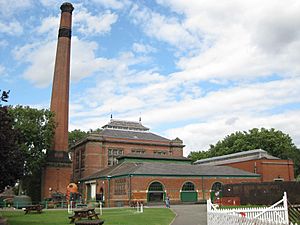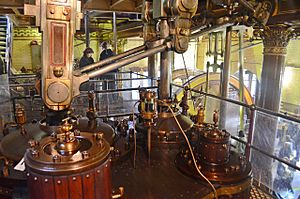Abbey Pumping Station facts for kids

Abbey Pumping Station, Leicester Museum of Science and Technology
|
|
| Lua error in Module:Location_map at line 420: attempt to index field 'wikibase' (a nil value). | |
| Established | 1972 |
|---|---|
| Location | Leicester, United Kingdom |
| Type | Science and Technology Museum |
| Key holdings | Steam engines, 'interactive toilets', steam shovel, buses |
| Architect | Stockdale Harrison |
The Abbey Pumping Station is a cool museum in Leicester, England. It's all about science and technology! You can find it on Corporation Road, right next to the National Space Centre. This museum has four huge steam engines that used to pump sewage. Now, it also shows off amazing things about transport, how public health works, light, optics, old toys, and how big buildings and bridges are made.
Contents
A Pumping Station for Leicester
The Abbey Pumping Station was built in 1891 by Leicester Corporation. It's located on the north side of Leicester, right by the River Soar. Its main job was to pump the town's sewage to a special farm at Beaumont Leys.
The building itself is very grand. It has a Victorian style and was designed by Stockdale Harrison in 1890. Inside, you'll find four huge beam engines. These engines were built by Gimson and Company of Leicester.
Why Was it Built?
Before this station, dealing with sewage was a big problem. In the 1850s, people started getting piped water and water closets (toilets). This meant more wastewater. Early systems struggled to keep the River Soar clean. Also, many homes still used "pail closets," which were like buckets. Getting rid of the waste from these was smelly and caused pollution.
A new solution was needed for the growing city. The answer was to pump all the sewage to a special "sewage farm" on higher ground. This farm was at Beaumont Leys. The Abbey Pumping Station took over from a smaller facility.
How it Worked
The pumping station received sewage from two main pipes. One came from the east of the city, and another ran along Abbey Lane. By 1912, Leicester had grown a lot. The station and its sewage farm were working hard. They could pump up to 20 million gallons of sewage a day!
In 1939, a very large ram pump was added. It was said to be the biggest of its kind in Europe. The station kept pumping Leicester's sewage until 1964. That's when electric pumps took over. A few years later, a new plant called Wanlip Sewage Treatment took over completely. The Abbey Pumping Station was no longer needed for its original job.
Becoming a Museum
In 1972, the building got a new life! It reopened as a museum of science and technology. Leicestershire Museums started running it. The giant beam engines were kept safe. Over time, they were carefully fixed up to work again.
The Abbey Pumping Station is one of several historic pumping stations that have been saved. In 1997, Leicester City Council took over running the museum.
What You Can See at the Museum
At the museum, you can see the amazing steam engines that used to pump sewage. There are also many interesting displays. These displays teach you about water and how sewage systems work. You can also watch old films in a special theatre.
The museum has collections of old items. These range from household appliances to old trams. Outside, there are even bigger items of industrial history. This includes a narrow-gauge railway and some cool old vehicles.
The Powerful Beam Engines
The four steam engines at the museum were built in Leicester by Gimson and Company. They are special because they are rare examples of Woolf compound rotative beam engines. Even when they were built, these engines were considered an older, but very reliable, design.
These engines are huge! Their cylinders are about 76 cm by 177 cm, and 122 cm by 259 cm. The big cast-iron flywheels are 6.4 meters across. The long steel beams are about 8.5 meters long. Each engine had 200 horsepower.
They could pump 208,000 imperial gallons of sewage every hour! That's a lot of water.
All four engines have been fixed up and can work again. This was done by a team of volunteers called the Leicester Museums Technology Association. It's the only place in the world where you can see four working examples of the same type of beam engine in one building! The volunteers are still working to maintain the engines, especially Engine No. 1, which they restored over four years.
Museum Collections and Events
The Pumping Station is usually open daily from 11 AM to 4:30 PM. On special "steam days," you can see the engines working with real steam! You can also see other steam-powered machines and early engines that run on fuel.
Transport Collection
The museum has a narrow-gauge railway. It's usually run by a small locomotive named Leonard. This engine was built in 1918. There are also four diesel locomotives that can be used if needed.
You can also see a collection of old road vehicles. These are sometimes operated on special days. The exhibits include:
- Several fire engines
- Old buses
- An 1894 Aveling and Porter steam roller
- Several diesel road rollers
- A Bedford fish and chips van
- An old tower wagon from Leicester Corporation Tramways
- An Austin K2 lorry that used to deliver beer
Buses You Can See
- 1939 Leicester City Transport: AEC Renown 0664 CBC 921. This bus is fully restored and can be driven.
- 1958 Delaine Coaches: Leyland Tiger Cub PSUC1/2 MTL 750. This bus is also fully restored and can be driven.
- 1958 Leicester City Transport: Leyland Titan PD3/1 TBC 164. This double-decker bus is fully restored and can be driven.
A Museum Mystery
Some people say that the ghost of an engineer haunts the building. He is said to have died in 1890 after falling from a high place while working at the Pumping Station.
See also







